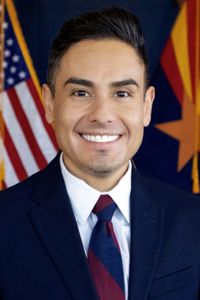Daniel Ruiz II
Daniel Ruiz is a Republican political aide in the state of Arizona. He was the chief of staff for the gubernatorial administration of Arizona Gov. Doug Ducey (R).[1]
Career
Early career
Prior to becoming Gov. Doug Ducey's chief of staff, Ruiz served as Arizona's chief operating officer. From August 2018 to November 2018, Ruiz was Gov. Ducey's communications director. In December of that year, Ruiz was promoted to senior advisor to the governor. He also served as Gov. Ducey's director of media affairs from 2015 to 2018.[1]
Doug Ducey chief of staff
On August 5, 2021, Gov. Doug Ducey appointed Ruiz chief of staff to replace Daniel Scarpinato.[1] Upon the appointment, Gov. Ducey said, "Daniel [Ruiz] has been involved in nearly every issue we have tackled. Whether it’s operations, strategy, policy, messaging or crisis management, Daniel has been a rock our team has relied on to guide us through challenges and opportunities."[1]
Chief of staff
- See also: Gubernatorial chiefs of staff
In 2021, Ballotpedia identified Daniel Ruiz II as a gubernatorial chief of staff. A chief of staff is the lead staff member of an administration and is responsible for implementing the governor's agenda.
The role is both a managerial and advisory position, although specific duties vary by each administration. The chief of staff typically has the following responsibilities, according to the National Governors Association (NGA):[2]
- Control access to the governor and manage the governor's calendar;
- Monitor the flow of information to the governor on policy issues;
- Oversee gubernatorial Cabinet and staff; and
- Manage and communicate the governor's policy agenda to the state legislature and the public.
In terms of policymaking, the NGA notes that a chief of staff is responsible for bringing policy and communications together: "The chief is responsible for overseeing the development of the governor’s policy agenda. The policy director or advisor is typically responsible for shaping the general concepts and specific details of the agenda with input from the communications director, policy staff, and cabinet members. The chief often must take charge and bring the pieces together coherently."[2]
See also
External links
Footnotes
| |||||||




